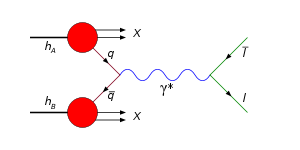Drell–Yan process

The Drell–Yan process occurs in high energy hadron–hadron scattering. It takes place when a quark of one hadron and an antiquark of another hadron annihilate, creating a virtual photon or Z boson which then decays into a pair of oppositely-charged leptons. This process was first suggested by Sidney Drell and Tung-Mow Yan in 1970[1] to describe the production of lepton–antilepton pairs in high-energy hadron collisions. Experimentally, this process was first observed by J.H. Christenson et al.[2] in proton–uranium collisions at the Alternating Gradient Synchrotron.
Overview
The Drell–Yan process is studied both in fixed-target and collider experiments. It provides valuable information about the parton distribution functions (PDFs) which describe the way the momentum of an incoming high-energy nucleon is partitioned among its constituent partons. These PDFs are basic ingredients for calculating essentially all processes at hadron colliders. Although PDFs should be derivable in principle, current ignorance of some aspects of the strong force prevents this. Instead, the forms of the PDFs are deduced from experimental data.
Sensitivity to Light Quark Flavor Asymmetry in the Proton
One recent measurement using Drell-Yan scattering probed the flavor asymmetry of the proton.[3][4][5] It had been naively believed that the quark sea in the proton was formed by quantum chromodynamics (QCD) processes that did not discriminate between up and down quarks. To leading order in the strong interaction coupling constant, αs, the ratio of the Drell-Yan cross section from a proton beam on a deuterium target to a proton beam on a proton target is given by
![{\frac {\sigma ^{{pd}}}{2\sigma ^{{pp}}}}={\frac {1}{2}}\left[1+{\frac {{\bar {d}}(x)}{{\bar {u}}(x)}}\right]](/2014-wikipedia_en_all_02_2014/I/media/b/d/7/5/bd75c2f65a05a87d633f08f8c59f608c.png)
Z boson production
The production of Z bosons through the Drell–Yan process affords the opportunity to study the couplings of the Z boson to quarks. The main observable is the forward–backward asymmetry in the angular distribution of the two leptons in their center-of-mass frame.
If heavier neutral gauge bosons exist (see Z' boson), they might be discovered as a peak in the dilepton invariant mass spectrum in much the same way that the standard Z boson appears by virtue of the Drell–Yan process.
See also
- NA51 experiment
- Fermilab E-866/NuSea
- Fermilab E-906/SeaQuest
References
- ↑ Drell, S.D.; Yan, T.-M. (1970). "Massive Lepton-Pair Production in Hadron-Hadron Collisions at High Energies". Physical Review Letters 25 (5): 316–320. Bibcode:1970PhRvL..25..316D. doi:10.1103/PhysRevLett.25.316.
- And erratum in Drell, S. D.; Yan, T.-M. (1970). Physical Review Letters 25 (13): 902. Bibcode:1970PhRvL..25..902D. doi:10.1103/PhysRevLett.25.902.2.
- ↑ Christenton, J. H.; et al. (1970). "Observation of Massive Muon Pairs in Hadron Collisions". Physical Review Letters 25 (21): 1523–1526. Bibcode:1970PhRvL..25.1523C. doi:10.1103/PhysRevLett.25.1523.
- ↑ Hawker, E. A.; et al. (1998). "Measurement of the light anti-quark flavor asymmetry in the nucleon sea". Physical Review Letters 80 (17): 3715–3718. arXiv:hep-ex/9803011. Bibcode:1998PhRvL..80.3715H. doi:10.1103/PhysRevLett.80.3715.
- ↑ Towell, R. S.; et al. (2001). "Improved measurement of the d/u asymmetry in the nucleon sea". Physical Review D 64 (5): 052002. arXiv:hep-ex/0103030. Bibcode:2001PhRvD..64e2002T. doi:10.1103/PhysRevD.64.052002.
- ↑ Baldit, A.; et al. (1994). "Study of the isospin symmetry breaking in the light quark sea of the nucleon from the Drell-Yan process". Physics Letters B 332: 244–250. Bibcode:1994PhLB..332..244B. doi:10.1016/0370-2693(94)90884-2.